GeForce GTX 750 Ti vs Radeon R7 265: Best 1080p Graphics Card
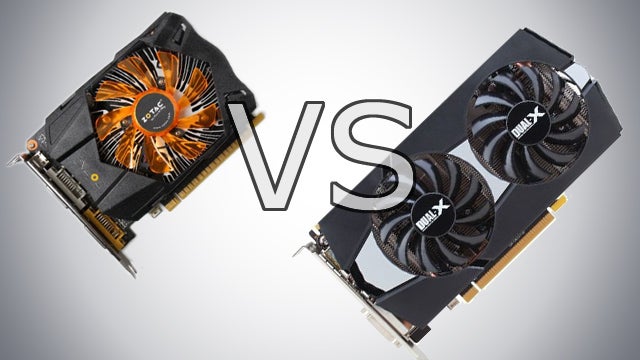
GeForce GTX 750 Ti vs Radeon R7 265 review
Enthusiast GPUs are so powerful that only those with 4K screens or multiple monitors need to worry about spending hundreds on the latest cards. That’s great news for the rest of us because, these days, high-quality single-screen gaming doesn’t cost much more than £100.
AMD and Nvidia have launched two new cards into this competitive market segment. The GeForce GTX 750 Ti uses the new Maxwell architecture, which is designed to produce great framerates while drastically reducing power consumption. Nvidia’s done this by redesigning its streaming multiprocessors: instead of using huge blocks of processors, Maxwell divides them into much smaller chunks that can be deployed more efficiently.
You may also like our Best SSD group test
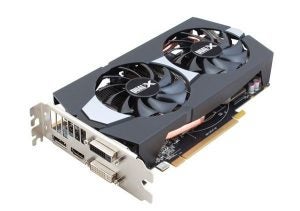
AMD Radeon R7 265
The GTX 750 Ti is clocked to 1,020MHz with an average boost of 1,085MHz, and it’s paired with 2GB of 1,350MHz GDDR5 memory. It’s got 640 stream processors and 1.87 billion transistors.
The GTX 750 Ti trades blows with the AMD Radeon R7 265, which is a boosted version of the Pitcairn core used in last year’s £200 Radeon HD 7850. The AMD card’s stock and boost speeds of 900MHz and 925MHz can’t match Nvidia, but its 2GB of GDDR5 memory runs at 1,400MHz – and it’s got 1,024 stream processors and 2.8 billion transistors.
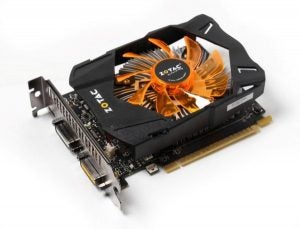
Nvidia GTX 750 Ti
Little separates these cards at the checkout. AMD’s cards are rarer, and a stock-speed model costs at least £124; GTX 750 Ti cards are more numerous and cost at least £114 for a stock design.
We’ve run Battlefield 4, Bioshock Infinite, Batman: Arkham Origins and Crysis 3 at their most demanding settings and 1,920 x 1,080. We’ve loaded 3DMark’s Ice Storm, Cloud Gate and Fire Strike benchmarks to determine each card’s theoretical power, and we’ve locked and loaded the Unigine Heaven test to further evaluate raw power.
Cinebench R15’s OpenGL benchmark tests each card’s abilities with GPU-heavy workloads, and PC Mark 8 uses Home and Creative workload benchmarks to judge application performance. GPU overclocking is easier than ever, so we’ve given both of these cards a boost. Both cards were only tested at quoted speeds if they remained stable throughout all tests.
We’ve also measured idle and peak temperatures, and the idle and peak power requirements of our test rig, which comprises of an Asus X79-Deluxe motherboard, Intel Core i7-4960X processor, 16GB of RAM and a 1TB hard disk.
Looking to spend more? Try our Radeon R9 280X vs GeForce GTX 770 comparison
GeForce GTX 750 Ti vs Radeon R7 265 in Battlefield 4

| AMD Radeon R7 265 | Nvidia GeForce GTX 750 TI | |||
|---|---|---|---|---|
| Minimum | Average | Minimum | Average | |
| Battlefield 4, High at 1080p | 46 fps | 53.66 fps | 35 fps | 46.83 fps |
| Battlefield 4, Ultra at 1080p | 29 fps | 34.33 fps | 24 fps | 30.12 fps |
There was only one winner in Battlefield 4.
In the High-quality benchmark the AMD’s minimum and average framerates of 46fps and 53.66fps easily bested Nvidia – the former figure was nine frames ahead, and the latter was almost seven frames faster.
The gap closed at Ultra quality, but the red team still dominated. AMD’s 29fps minimum was only one frame short of a playable 30fps – the Nvidia card was five frames worse – and the R7 265 hit an average of 34.33fps, which was four frames better than the GTX 750 Ti. The AMD card’s better minimum framerate result is of particular importance, as it means the game won’t judder mid-game.
It’s no surprise AMD took an early lead – Battlefield 4 is a flagship title from AMD’s in-house gaming programme, so the firm’s engineers will have visited DICE and optimised the game for Radeon cards.
Best for Battlefield 4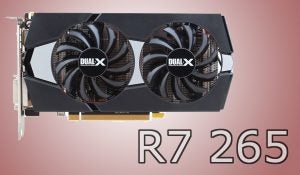
![]()
GeForce GTX 750 Ti vs Radeon R7 265 in Bioshock Infinite

| AMD Radeon R7 265 | Nvidia GeForce GTX 750 TI | |||
|---|---|---|---|---|
| Minimum | Average | Minimum | Average | |
| Bioshock Infinite: V. High at 1080p | 30 fps | 70.8 fps | 16.38 fps | 65.2 fps |
| Bioshock Infinite Ultra at 1080p | 16.38 fps | 60.1 fps | 10.2 fps | 46.34 fps |
AMD continued its good form in Bioshock Infinite – a modern game that’s very scalable, in part thanks to its console-friendly development.
At Very High settings both cards had no trouble, but the R7 265 led the way with an average of 70.8fps to the GTX 750 Ti’s 65.2fps. The R7 265’s minimum of 30fps means the game will be smooth at every moment, which is more than we can say for Nvidia. Its minimum framerate of 10.2fps is poor and, while that’s just a momentarily lapse in smoothness, that judder will be jarring during gameplay.
We cranked the detail up to Ultra and both cards remained playable: the R7 265 hit 60.1fps, with the Nvidia at 46.34fps. Nvidia’s hardware still languished with a minimum framerate of 10.2fps, but the AMD card slipped to a 16.38fps minimum – you’ll notice both cards slip during demanding moments.
It’s another AMD victory, but the R7 265’s mediocre minimum framerates mean you’ll still notice occasional stutters during more intensive moments.
Best for Bioshock Infinite
![]()
GeForce GTX 750 Ti vs Radeon R7 265 in Crysis 3

| AMD Radeon R7 265 | Nvidia GeForce GTX 750 TI | |||
|---|---|---|---|---|
| Minimum | Average | Minimum | Average | |
| Crysis 3: High at 1080p | 30 fps | 45.68 fps | 22 fps | 34.33 fps |
| Crysis 3: Very High at 1080p | 26 fps | 38.73 fps | 17 fps | 46.34 fps |
Crytek’s latest shooter is the most demanding title here, and it’s another game that’s been tweaked by AMD’s engineers.
At High settings the R7 265 averaged 45.68fps and, just as importantly, it hit a minimum 30fps – so there’s little chance of this game stuttering when loading particularly demanding assets. The Nvidia card wasn’t as smooth, with a fine average of 38.73fps undermined by a sub-30fps minimum.
The situation worsened for Nvidia at Very High settings. Neither card hit 30fps minimums, but the AMD GPU was better – and the R7 265’s average of 34.33fps was playable, while the GTX 750 Ti’s 25.31fps wasn’t.
SEE ALSO: Xbox One vs PS4
Best for Crysis 3
![]()
GeForce GTX 750 Ti vs Radeon R7 265 in Batman: Arkham Origins

| AMD Radeon R7 265 | Nvidia GeForce GTX 750 TI | |||
|---|---|---|---|---|
| Minimum | Average | Minimum | Average | |
| Arkham Origins: Very High at 1080p | 12 fps | 58 fps | 45 fps | 58 fps |
Batman is a new game for our graphics card testing, and it’s the only title to veer from AMD dominance. It’s part of Nvidia’s The Way It’s Meant To Be Played programme, so it’s optimised for the green team’s hardware; it’s no surprise this was the GTX 750 Ti’s best test.
The GTX 750 Ti’s minimum of 45fps battered the R7 265’s 12fps – the AMD card’s figure will manifest itself as stuttering. Both cards recorded averages of 58fps, with the Nvidia’s maximum framerate of 88fps besting the AMD’s 79fps.
Nvidia’s optimisations clearly work: the GTX 750 Ti has a smooth minimum framerate an excellent average.
Best for Batman: Arkham Origins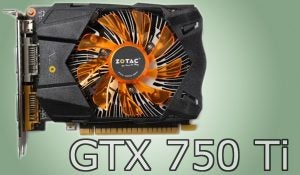
![]()
GeForce GTX 750 Ti vs Radeon R7 265: Theoretical Gaming Tests
| AMD Radeon R7 265 | Nividia GeForce GTX 750 TI | |||
|---|---|---|---|---|
| Minimum | Average | Minimum | Average | |
| Unigine Extreme at 1080p | 12.6 fps | 23.1 fps | 12 fps | 19.4 fps |
| 3D Mark Fire Strike (Graphics) | 4920 | 4113 | ||
| 3D Mark Cloud Gate (Graphics) | 34,285 | 31,000 | ||
| 3D Mark Ice Storm (Graphics) | 260,700 | 238,867 | ||
These tests illustrate the theoretical power of each GPU, and they confirmed what our real-world testing had already shown: the R7 265 is very fast indeed.
Its average of 23.1fps in Unigine Heaven outpaced Nvidia’s 19.4fps, and the AMD card’s minimum and maximum scores of 12.6fps and 48.4fps are better than the GTX 750 Ti’s 12fps and 40fps – showing that, while both cards had similar minimums, the R7 265 had more legs than its rival.
The R7 265 took the overall crown in all three 3DMark benchmarks, with the most significant victory coming in the Fire Strike test. This is the most demanding 3DMark run, with the R7 265’s overall score of 4,630 a significant distance ahead of Nvidia’s 3,926.
The GTX 750 Ti outpaced the R7 265 in the Cloud Gate and Ice Storm physics tests, although the gap was always slim – and, in the tougher Fire Strike test, AMD took back the lead.
Best in Theoretical Gaming Tests
![]()
GeForce GTX 750 Ti vs Radeon R7 265: Theoretical Application Tests
| AMD Radeon R7 265 | Nividia GeForce GTX 750 TI | |||
|---|---|---|---|---|
| Cinebench R15 (OpenGL) | 99.01 fps | 100.81 fps | ||
| PC Mark 8 Home | 4,399 | 4,388 | ||
| PC Mark 8 Creative | 4,911 | 4,141 | ||
The GTX 750 Ti’s factory-fresh Maxwell architecture took a surprising lead in Cinebench with an impressive score of 100.81fps; the R7 265 squeezed in behind with 99.01fps.
The R7 265 took back ground in PC Mark 8’s tests, which evaluate application performance.
The Home test simulates web browsing, word processing, gaming, photo-editing and video chat, so it’s a good indication of general performance. Here, AMD’s card took the lead with 4,399 points – but that’s barely ahead of the 4,388 result from the GTX 750 Ti.
The gap widened in PC Mark’s Creative test, which includes photo editing, video editing and media transcoding tests alongside group video chat, gaming and web browsing. The AMD card’s increased ability showed, scoring an impressive 4,911 points – easily enough to outrun the GTX 750 Ti’s 4,141 result.
Best in Application Tests
![]()
GeForce GTX 750 Ti vs Radeon R7 265: Power, Heat and Noise
| AMD Radeon R7 265 | Nividia GeForce GTX 750 TI | |||
|---|---|---|---|---|
| Idle | Peak | Idle | Peak | |
| Power Consumption | 81 Watts | 266 Watts | 74 Watts | 169 Watts |
| Temperature | 37C | 71C | 34C | 66C |
There’s no doubting of Maxwell’s efficiency improvements: our test rig’s idle power consumption of 74W is a little lower than the R7 265’s 81W score, but the GTX 750 Ti rig pulled just 169W from the mains when the GPU was stress-tested at 100% – a huge 97W less than the R7 265 needed.
The fact that Nvidia’s hardware is playable in almost every game while consuming so little power is impressive, and it makes AMD’s rebadged hardware look decidedly old-hat.
The GTX 750 Ti continued its good form in temperature tests, where its top temperature of 66°C was five degrees chillier than the R7 265.
Finally, it’s a clean sweep for Nvidia. Neither card is too hot, but the big difference here is power consumption – and Maxwell is far more efficient than AMD’s older part.
Best for Effeciency
![]()
GeForce GTX 750 Ti vs Radeon R7 265: Overclocking
Nvidia hasn’t done well so far, but that changed when we overclocked: the GTX 750 Ti returned spectacular results.
Maxwell has already proved frugal, and it’s got huge headroom: we added 250MHz to both the core and the memory clocks without any instability, which is a huge boost for any graphics card. We overclocked the R7 265’s core by 125MHz and its memory by 100MHz, but neither AMD’s driver nor MSI Afterburner allowed further tweaks.
The GTX 750 Ti’s extra speed saw it overhaul the AMD card in Nvidia-optimised title Batman: Arkham Origins. The GTX 750 Ti’s average improved from 58fps to 81fps: a phenomenal jump that easily beat the 64fps overclocked AMD average. The Nvidia’s minimum framerate of 54fps easily beat the R7 265’s revised 12fps minimum.
Nvidia also overtook AMD in Bioshock Infinite – but only just. The Nvidia chip’s new 67.4fps average was just ahead of the 67.03fps from the overclocked Radeon, but the R7 265’s minimum of 16.52fps was almost twice as good as the 750 Ti could manage.
In two other games tests Nvidia closed the gap, but couldn’t quite catch up. The overclocked R7 265 averaged 38.65fps in Battlefield 4 with a playable 32fps minimum, but the GTX 750 Ti was four frames behind in both tests. In Crysis 3, the Radeon averaged 36.83fps – and while that’s only two frames better than its stock speed score, it’s still enough to outpace the overclocked Nvidia’s 30.05fps average.
We only saw minor improvements from both cards in Unigine Heaven, with AMD still leading, and the Radeon maintained its lead in 3D Mark Fire Strike – the R7 265’s overclocked score of 5,164 points was more than 600 points ahead. Nvidia remained better in Cinebench R15, and little changed in PC Mark 8.
There was little movement in thermal benchmarks: the R7 265’s power usage jumped to 284W, while the Maxwell card remained impressively low at 177W
For pure overclocking, Nvidia wins. Maxwell has much more headroom than its AMD rival, and our stable 250MHz tweaks saw the GTX 750 Ti beat the R7 265 in two benchmarks and significantly close gaps in the rest, all while remaining cooler and more frugal than AMD.
Best for Overclocking
![]()
Other Things to Consider
The cards we’ve tested are standard designs, and the market will be flooded by cards with a combination of enhancements, from overclocked cores and extra memory to passive or low-profile coolers.
Right now, Nvidia leads the way. Its GTX 750 Ti has been out longer, so there’s plenty of choice: the most powerful third-party card available at the moment boosts the core from 1,020MHz to 1,202MHz – another huge leap.
Most current third-party cards concentrate on overclocks, and they’re larger dual-fan models that stretch around 215mm from front to back – but Zotac and Gainward sell single-fan versions that are around 160mm long, and are ideal for smaller PCs. Overclocks and smaller versions with both cost a little extra cash – the priciest GTX 750 Ti, right now, is £129.
There’s not much choice on the AMD side: only two third-party R7 265s are available now, and they’re both larger dual-fan models at stock speeds. The pricier of the two is £132.
It’s worth considering your own PC before you drop money on a new GPU. AMD’s chip is faster, but Nvidia’s card is more versatile: its 60W power requirement means that some cards use no power plug, which is something always required with the 150W R7 265. The GTX 750 Ti’s smaller profile also means it’ll be a good fit in small-form-factor or passive systems.
We anticipate more R7 265 models emerging with better overclocks and different designs, but Nvidia will likely lead the way in this department: over the new couple of months we anticipate single-slot models and even passive cards being released.
AMD has made great play of its Never Settle bundle, with free games bundled with new cards, but the R7 265 isn’t a part of this bundle. The GTX 750 Ti has a better offering: buy the GeForce and you’ll quality for £90 of in-game credit split evenly between online games Heroes of Newerth, Path of Exile and Warface. It’s not much use if you don’t play these games, but at least it’s something.
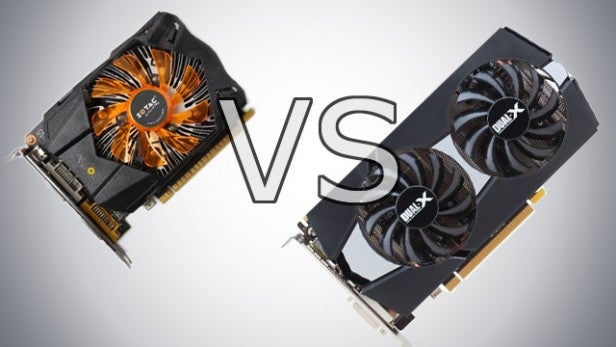
![]()
GeForce GTX 750 Ti vs Radeon R7 265: Which should you buy?
These two cards have similar prices, but they excel in different areas: AMD’s hardware is faster in almost every benchmark, so this is the card to buy if you’re looking for raw speed without having to overclock, tweak or pay attention to the physical size of the GPU.
Nvidia’s GTX 750 Ti isn’t immediately impressive, losing out in almost every test, but it still plays every game on one screen – and the Maxwell architecture excels elsewhere. It’s far more frugal, and can be bought in a wider variety of SKUs, and the huge overclocking potential means it closes the performance gap with AMD – which means it’s perfect for tweakers, too.
Nvidia deserves applause for the innovative Maxwell architecture, which packs in plenty of power and huge efficiency – we can’t wait to see what this new hardware does when it’s used for high-end cards.
Right now, though, the R7 265 delivers significantly better stock-speed framerates and hangs onto its advantage when overclocked, too. If you’re looking to spend around £120 for single-screen gaming, the R7 265 is the best bet for most people, though the GTX 750 Ti is worth considering depending on your needs and expertise.
Next, read our group test to find the best cheap graphics card


